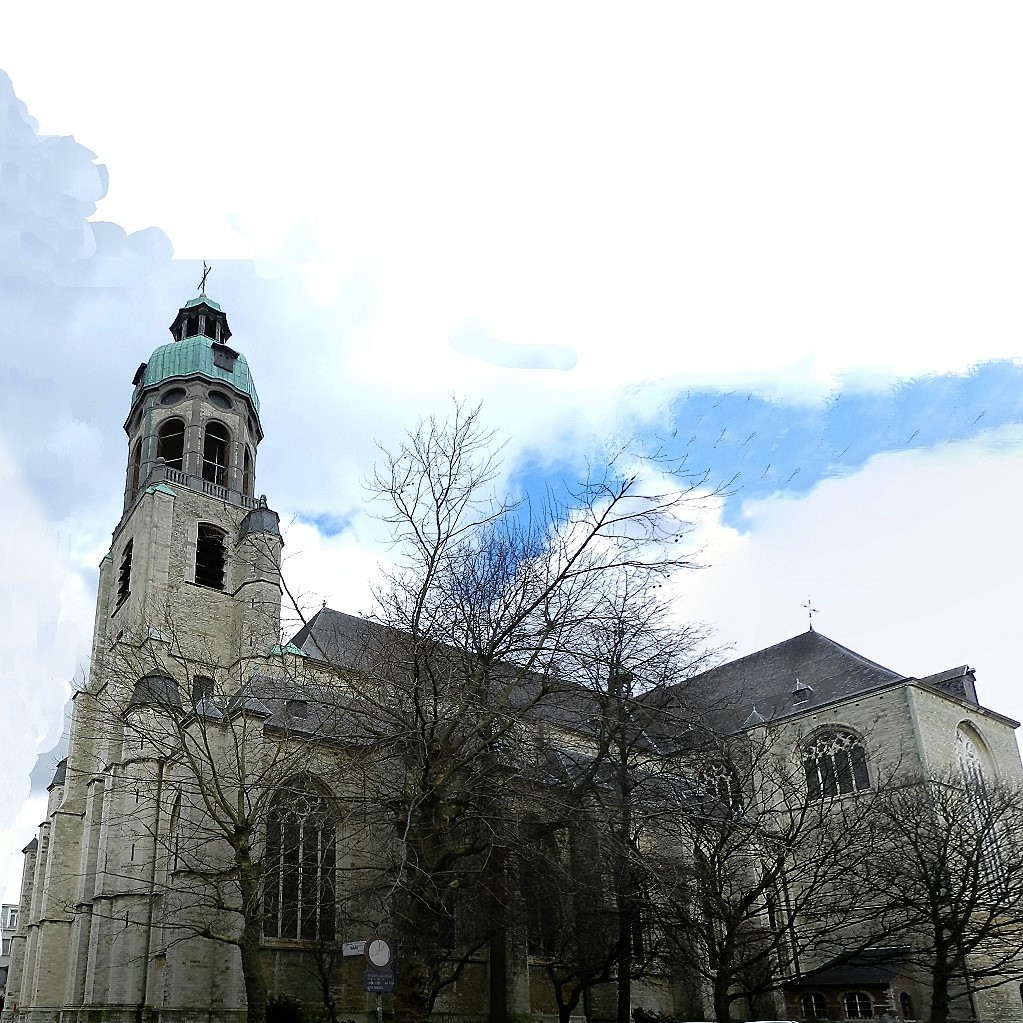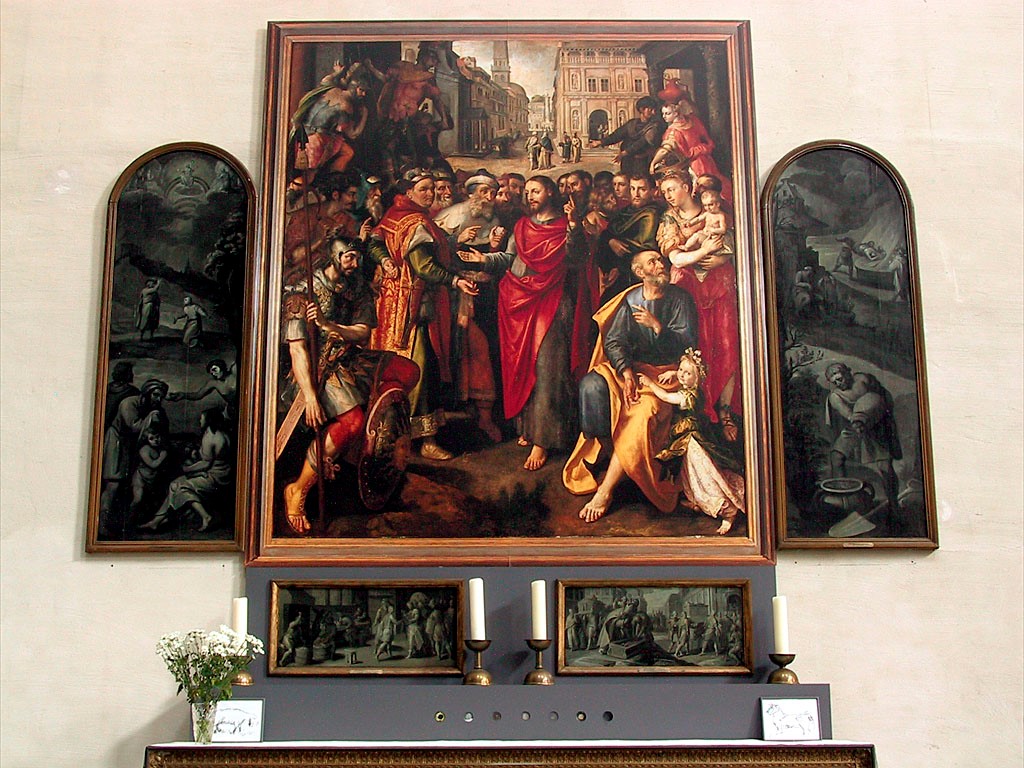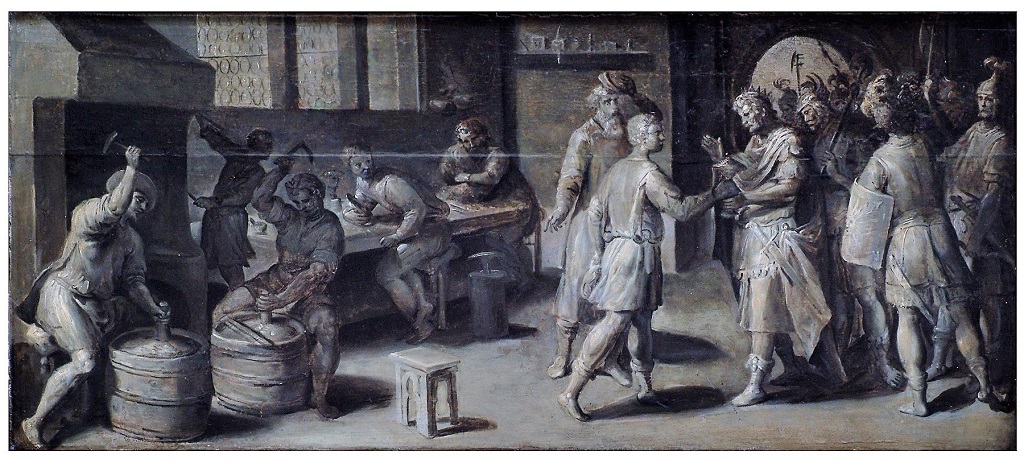Antwerp's St Andrew's Church, a revelation.
The minters' altar of saint Eligius
Once St Andrews’ had been consecratedIn the Roman Catholic Church, the moment when, during the Eucharist, the bread and wine are transformed into the body and blood of Jesus, the so-called transubstantiation, by the pronouncement of the sacramental words. (1529), it was taken for natural that the Mint – situated on the corner of Oever and Kloosterstraat since 1470 – should change the location of its altarThe altar is the central piece of furniture used in the Eucharist. Originally, an altar used to be a sacrificial table. This fits in with the theological view that Jesus sacrificed himself, through his death on the cross, to redeem mankind, as symbolically depicted in the painting “The Adoration of the Lamb” by the Van Eyck brothers. In modern times the altar is often described as “the table of the Lord”. Here the altar refers to the table at which Jesus and his disciples were seated at the institution of the Eucharist during the Last Supper. Just as Jesus and his disciples did then, the priest and the faithful gather around this table with bread and wine.. The minters’ altar moved from the St Walburga Church, close to the Steen, to the new parish church right around the corner (of Muntstraat). The minters were a significant professional category in this new parish community, as is apparent from the list of benefactors and church wardens, and from at least 27 gravestones for mint personnel. None of these gravestones survive today.
Along with seven other altars, the new minters’ altar was consecrated in 1530, with Eloy (Eligius) as its patron saintThis is a title that the Church bestows on a deceased person who has lived a particularly righteous and faithful life. In the Roman Catholic and Orthodox Church, saints may be venerated (not worshipped). Several saints are also martyrs.. At the time, the altar stood against the eastern wall of the northern transeptThe transept forms, as it were, the crossbeam of the cruciform floor plan. The transept consists of two semi transepts, each of which protrudes from the nave on the left and right., until it was almost entirely destroyed by protestant iconoclasts in 1566. Immediately after Antwerp had been liberated in 1585, the minters had a new altar raised, and crowned it with a statue of St Eligius. Afterwards, they commissioned an altar screen with a triptych by Maerten de Vos (1532-1603), one of the best-known painters of Antwerp at the time. The artwork, which signed and dated in the lower left corner, was inaugurated in 1601. In its closed state, the outer panels in grisaille become visible; in addition, two grisaille panels (fixed against the wall) can be seen. These last panels depict Avarice and Generosity, and are sometimes attributed to Hendrick van Balen (first quarter of the 17th century).
The original altar equipment includes the 17th-century set of an altar cross and four chandeliers in driven brass, embellished with the weapon of the ducal Mint.
Joseph II abolished the Corporation of the Minters of Brabant in 1786. Two years later, the French State confiscated the colourful triptych by De Vos. Though the church wardens tried to recover the wonderful altarpiecePainted and/or carved back wall of an altar placed against a wall or pillar. Below the retable there is sometimes a predella. after the Concordat of 1801, the painting eventually ended up elsewhere: at the Royal Museum of Fine Arts Antwerp – that is, in its subterranean archive, away from the public eye. The grisailles, the predellaThe base of an altarpiece. Like the altarpiece, the predella may be painted or sculpted. and the extra side panels remained in the church. A revised reconstruction of the altarpiece with the addition of contemporary accents was made in 2001, exactly 400 years after the altarpiece was originally realized, and on the occasion of the introduction of the Euro as European currency on 1 January 2002.
Iconography
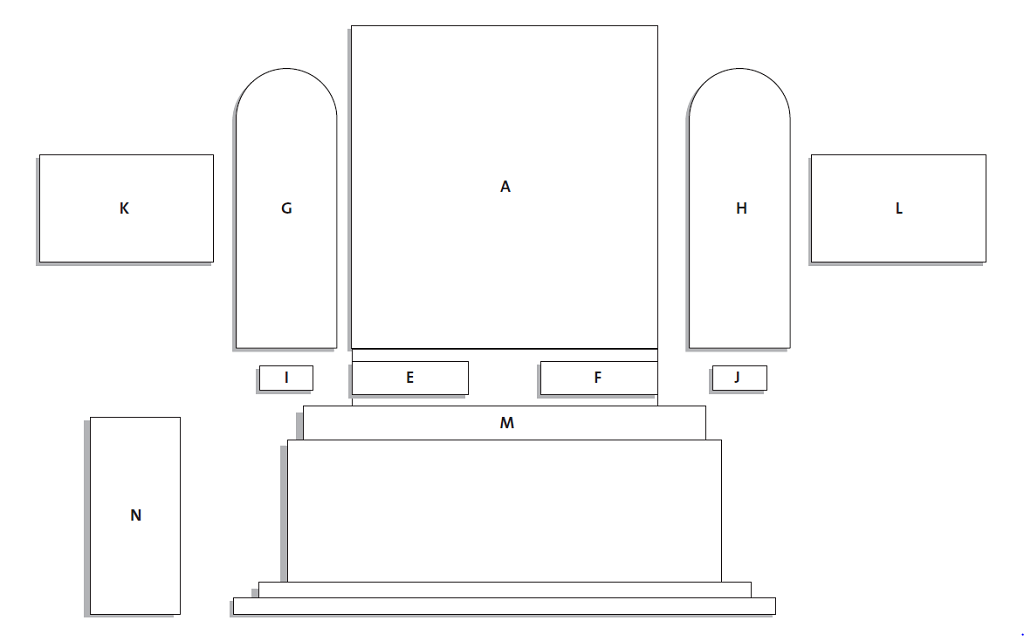
(E) Left predella panel:
Eligius, Master of the Mint, Receives the King in the Mint Studio
The predella consists of two panels in grisaille, each depicting a representative moment in the life of St Eligius (7th century). On the right, king Chlothar II and his retinue enter the studio of Bobbon, Eligius’ teacher. The young Eligius offers a cup to his sovereign. Bobbon stands behind the youth and lifts his cap in greeting. In the back left, two men are at work at a long table. On the far left, a workmate melts precious metal in a tall chimney; next to him, we see two blacksmiths at work. This is a vivid depiction of a minter’s studio anno 1601.
St Eligius embodies ability and honesty: though he is a silversmith, he is ‘pure gold’ when it comes down to it. Hence, he was named mint master to the Frankish kings. While Eligius could undoubtedly have ‘capitalized’ greatly on his status as mint master, he chose a different path and became a priestIn the Roman Catholic Church, the priest is an unmarried man ordained as a priest by the bishop, which gives him the right to administer the six other sacraments: baptism, confirmation, confession, Eucharist, marriage, and the anointing of the sick. and missionary. He was the first visitor known by name to come to Antwerp by ship. In fact, Eligius’s life story is the first one to mention the name ‘Andoverpia’; therefore, Eligius is considered to be Antwerp’s first historical figure. Later, he became the patron saint of minters, who recognized themselves in St Eloy’s professional example.
In addition, the triptych depicts four biblical scenes that deal with money: these provide the viewer with a meditation on money.
(A) Middle panel: The Emperor’s Tax
“The legal experts and chief priests were watching Jesus closely and sent spies who pretended to be sincere. They wanted to trap him in his words so they could hand him over to the jurisdiction and authority of the governor. They asked him, “Teacher, we know that you are correct in what you say and teach. You don’t show favoritism but teach God’s way as it really is. Does the Law allow people to pay taxes to Caesar or not?” Since Jesus recognized their deception, he said to them, “Show me a coin. Whose image and inscription does it have on it?” “Caesar’s,” they replied. He said to them, “Give to Caesar what belongs to Caesar and to God what belongs to God.” They couldn’t trap him in his words in front of the people. Astonished by his answer, they were speechless.”
Christ is at the centre, answering the question of those pretending to be pious. Although their question seems to originate in respect for the law, it is in fact a trick question. When Jesus answers affirmatively, he does not conform to Jewish expectations about the Messiah: for the latter, surely, was also supposed to promote the national rights of the Jewish people against the Roman occupiers. Should Jesus have answered negatively, then they could have accused him before the governor Pilate of being a rebel. The Jews who had hoped to trap Jesus, are therefore very surprised by his quick-witted answer: citizens have duties to God as well as to the state, so don’t abuse religion for politics, and vice versa.
(B) Left panel: The Temple Tax
[not included in the reconstruction]
Peter retrieves a coin from a fish’s jaws to pay taxes for Christ and for himself (Mt. 17:24-27). This confirms the middle panel’s message, to some extent.
(C) Right panel: A Poor Widow’s Contribution
(Mk. 12:41-44; Lk. 21:1-4)
[not included in the reconstruction]
Christ tells his disciples that the poor widow’s contribution is of greater value than that of the rich. A gift’s intended value is not merely derived from its absolute worth; in fact, it is at least equally dependent on its relative worth, that is, on the proportion of the gift to the giver’s entire property.
The side panels ‘highlight’ (in grisaille, that is) the dilemma: Generosity versus Avarice.
(H) Right panel: Avarice
This panel sits to the left of the middle panel – which, in iconographic terms, is the place of lesser ‘honour’. In the background, the rich owner of a sizeable stone house is pouring coins from a bag into a big pot, which he wants to bury. He hoards his money, paying no heed to the shabby figures milling about at their poor wooden hut; in despair, one of them has his head buried in his hands.
The background illustrates with great clarity that one’s behaviour on earth will be given an eternal dimension. Avarice will be punished with an isolated, hellish existence: in the presence of Christ (dressed in 17th century fashion), the rich miser is thrown into a smoking pit.
(G) Left panel: Charity
This panel sits to the right of the middle scene – the iconographic equivalent to ‘pride of place’. Two men take coins from a chest and give these to a poor, half-naked man. At his side, a benefactor offers a garment to a woman and child. In the centre, Jesus (dressed identically as in the other side panel) points out heaven to a kneeling man – alluding to the rich youth who asked what he should do “to have eternal life?” (Mt. 19:16).
In contrast to Avarice, Generosity is rewarded with the perspective of heaven. Surrounded by a heavenly retinue, Christ is sitting on a rainbow as the triumphant judge of the Final Judgement. He welcomes all who sought God’s goodness during their lives on earth. Seek, and ye shall find.
As an expression of love, generosity is given ‘flesh’ as attention for the dead: money may be used to honour your loved ones, amongst others. In fact, masses at this altar were dedicated, in the very first place, to the guild’s deceased.
(D) Closed outer wings:
Abraham Buys the Field Machpelah at Hebron
[not included in the reconstruction]
Abraham weighs 400 shekels of gold, the price for a field with a cave, which will serve as burial ground for his wife Sarah (Gen. 23).
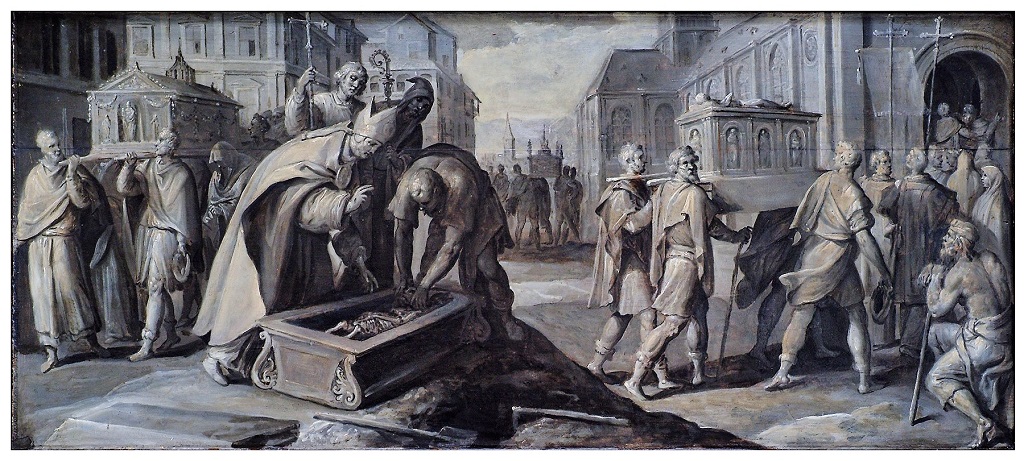
Dressed in his episcopal vestments, Eligius bends forward to bless a skeleton that has just been dug up from a deep pit and is being placed in a stone sarcophagus. Three groups of men are scattered across the painting; each group carries a reliquaryContainer for relics. Often this is a philatory: a decorated glass holder on a pedestal, in which a relic can be placed for veneration. It is important to know that relics cannot be worshipped, only venerated. to church on their shoulders.
In this situation, the craftsmanship of patron saint Eligius embodies care for the deceased – and particularly for the veneration of saints.
Art to meditate … on money
Although the minters may originally have intended to enhance their own prestige with a respectable work of art, this work in fact encourages the viewer to reflect on money as well. The artwork’s iconography speaks about paying taxes to the benefit of the community, about the intentional value of a donation, about spending money for the care of the deceased, and about generosity versus avarice. The 2001 reconstruction aimed to highlight this message with several additions, suggesting three questions for reflection:
- The question is not merely: “Which coin is minted: denarius, guilder, franc, euro?”
The candle stand (M), hidden behind the altar frontal at the top, depicts the evolution of the payment system in a nutshell.
1) Grain: initially, goods were being bartered – exchanged in some form – sometimes ‘for a song’.
2) Salt (sal, sel): later, goods were exchanged using fixed rates, such as rye or salt; see also ‘salary’ (ration of salt).
3) A Roman coin: a coin of the semi-deified Roman emperor Augustus valid from 30-36, that is, at the time of Christ. The word ‘mint’ originates in ancient Rome, where coins were minted near the temple of Juno Moneta. The Romans pioneered a minted coin that had value throughout the entire empire, an empire that sprawled across three continents: in other words, an intercontinental currency!
4) A Philip thaler from Antwerp (1572), minted at the Antwerp Mint, with the sign of the Antwerp hand.
5) A Belgian franc (1996). After Belgian independence (and specifically since 1833), the nation adopted the Belgian franc as its national currency, which was minted by the Royal Mint of Belgium in Brussels.
6) A Euro (2001). The Euro was introduced in the European Union on 1 January 2001. Not only does it symbolise intense trade within Europe, but it also signifies broader political cooperation and (inter)connectedness.
7) An empty niche for a (currently?) imaginary ‘Mundial’ or ‘Global’.
- It is more meaningful to ask the ethical question: “What do we ‘capitalize’ on?” (E)
Money is the justified remuneration that one may expect for the work (s)he has done: a salary, a pay, a livelihood. As Jesus said: “Workers deserve their pay.” (Lk. 10:7) One should be so lucky to be entirely rewarded for one’s daily labour in measures of happiness and satisfaction!
Artisanal work, as was being done in St Eloy’s minter’s studio, symbolizes the precision and elegant finish of professional labour. In these nonchalant times, those prized virtues have become under threat, as has honesty. The person of Eloy embodies both values of craftsmanship: ability and honesty. As a sterling silversmith, he is honest too: that’s pure gold!
- Finally, the ultimate question: “What should I do with the coins I’ve gathered: should I keep them only to myself, or am I prepared to consider the community as well [(A), (B), (C)] and to share with others in need, including the deceased? [(D) and (F)] Avarice or generosity?” It’s a moral dilemma between charity and selfishness. [(G) and (H), (I) and (J), (K) and (L)]
The painting’s background leaves little room for doubt: one’s behaviour on earth will eventually be given a more eternal dimension. Whereas charity (G) opens up to a heavenly perspective (Christ on a rainbow), avarice (H) is ‘rewarded’ with an isolated, hellish existence: the rich miser will be thrown into a smoking pit. This eternal dilemma is further depicted by added scenes.
In 2001, Dries Vanwijnsberghe produced two witty drawings with biblical symbolism.
(I) The Lamb of God is the ultimate symbol of Jesus who has given himself completely. A sheep gives meat, wool and milk. It is therefore a symbol of Generosity.
(J) The Golden Calf is the idol of the Jews in the desert (Ex. 32); hence the expression ‘to worship the golden calf’, or: to consider money to be of paramount importance. Next to the altar, as an extra frame, are two small and more colourful panels from the studio of the Francken family.
(K) The Acts of Mercy
The virtue of generosity is also illustrated by the painting The Acts of Mercy, at the left of the minters’ altar. In the 19th century, this picturesque work by Frans Francken the Younger (ca. 1600) was included in a chaplain’s funeral monument at the Sisters Capuchins Poor Clares in Sint-Rochusstraat. At the closure of their monasteryComplex of buildings in which members of a religious order live together. They follow the rule of their founder. The oldest monastic orders are the Carthusians, Dominicans, Franciscans, and Augustinians [and their female counterparts]. Note: Benedictines, Premonstratensians, and Cistercians [and their female counterparts] live in abbeys; Jesuits in houses. in 2001, the monument was transferred here, due to the thematic relation with the minters’ altar focus on Generosity. Incidentally, the representation of the city chaplains in tabard refers to the parish charity masters (Table of the Holy SpiritThe active power of God in people. It inspires people to make God present in the world. Jesus was ‘filled with the Holy Spirit’ and thus showed in his speech and actions what God is like. People who allow the Holy Spirit to work in them also speak and act like God and Jesus at those moments. See also ‘Pentecost’.), who took care of the poor of Saint Andrew’s parish in previous times.
Jesus embodies the Bible verse “those who remain in love remain in God” (1 Jn. 4:16) even more radically through his identification with the underprivileged: ‘when you have done it for one of the least of these brothers and sisters of mine, you have done it for me.’ (Mt. 25:40.45). This is given substance as follows:
“I was hungry and you gave me food to eat.
I was thirsty and you gave me a drink.
I was a stranger and you welcomed me.
I was naked and you gave me clothes to wear.
I was sick and you took care of me.
I was in prison and you visited me.”
(Mt. 25:35-36)
The seventh act of mercy, burying the death, was only added during the plague epidemics in the Middle Ages. The number seven also carries a stronger symbolical charge.
(L) In 2011, a pendant panel to this painting was acquired. This second panel – done in the typical style of the Francken studio as well, more specifically the style of Ambrosius I Francken – depicts Avarice, by using the parable of the rich man and poor Lazarus (Lk. 16:19-31). The depiction faithfully represents the gospelOne of the four books of the Bible that focus on Jesus’s actions and sayings, his death and resurrection. The four evangelists are Matthew, Mark, Luke, and John. ‘Gospel’ is the Old English translation of the Greek evangeleon, which literally means ‘Good News’. This term refers to the core message of these books. text: “There was a certain rich man who clothed himself in purple and fine linen, and who feasted luxuriously every day. At his gate lay a certain poor man named Lazarus who was covered with sores. Lazarus longed to eat the crumbs that fell from the rich man’s table. Instead, dogs would come and lick his sores.” To the miser begging for mercy in the afterlife, the message of this parable is hard and clear. He only receives this answer from Abraham: “Child, remember that during your lifetime you received good things, whereas Lazarus received terrible things. Now Lazarus is being comforted and you are in great pain.” And apparently, the gap between both is now too large. Even the miser’s compassionate question to warn his brothers, who are as rich and stingy as he was, falls on deaf ears. “They have Moses and the prophets;” if they don’t listen to those, they won’t be persuaded by anyone else either.
(N) Poverty isn’t a monopoly from pre-Euro times. Especially in big cities, the poor often live hidden lives. In the former Parish of Misery, helping the poor is being done even today. At the sacrificial altar, an invitation alludes to an expression that has, by now, become outdated: “Has the penny, um … Euro already dropped?”
